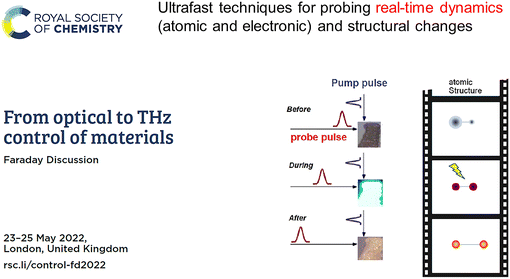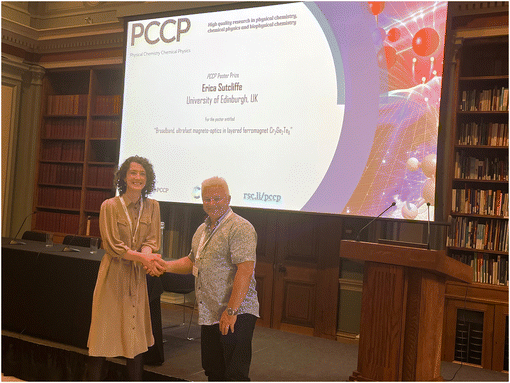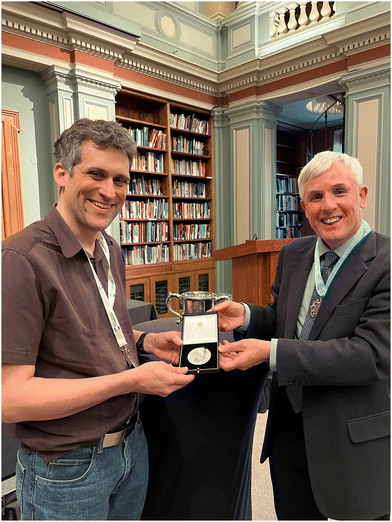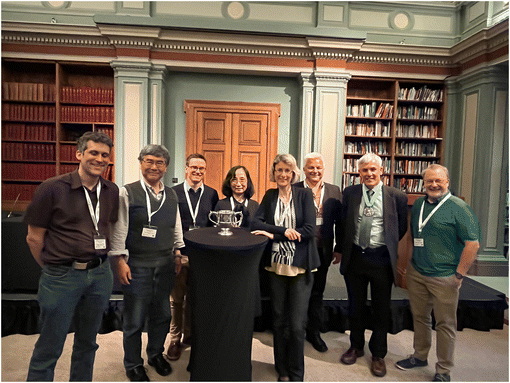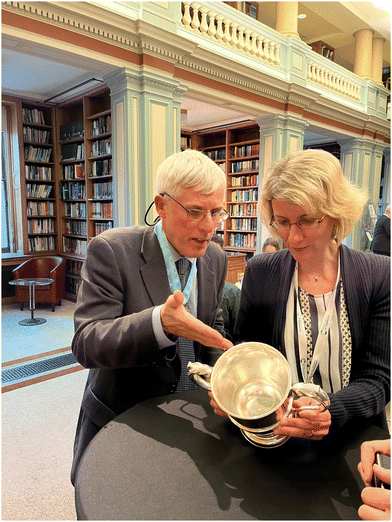Highlights from Faraday Discussion: From optical to THz control of materials, London, UK, May 2022
Aswathy V.
Girija†
 *a,
Martina
Basini†
*a,
Martina
Basini†
 b and
Habib
Rostami†
b and
Habib
Rostami†
 cd
cd
aCavendish Laboratory, University of Cambridge, J. J. Thomson Avenue, Cambridge, CB3 0HE, UK. E-mail: avg35@cam.ac.uk
bDepartment of Physics, Stockholm University, 106 91 Stockholm, Sweden
cDepartment of Physics, University of Bath, Claverton Down, Bath BA2 7AY, UK
dNordita, KTH Royal Institute of Technology and Stockholm University, Hannes Alfvéns väg 12, 10691 Stockholm, Sweden
First published on 17th March 2023
Abstract
The Faraday Discussion ‘From optical to THz control of materials’ was held in London, UK, and online on the 23rd, 24th, and 25th May 2022. The meeting brought together established and early-career scientists, postgraduate students, scientific editors, and industrial researchers in the field of spectroscopy and materials science from over ten different countries interested in exploring the physical properties of materials at ultrafast timescales driven by optical and THz excitations. This conference report provides highlights of this meeting and we give summaries of the presentations including the introductory lecture, all the papers discussed, and the concluding remarks.
Introduction
The Faraday Discussion on optical to THz control of materials took place from 23rd to 25th May 2022 in a hybrid format, online and in person at the Royal Society of Chemistry (RSC) headquarters in Burlington House, Piccadilly, London. For several delegates attending in London, this edition of the Faraday Discussion was the first in-person meeting since the Covid-19 pandemic, and therefore a long-awaited opportunity to meet and interact with fellow researchers. The historic RSC library provided the perfect backdrop for stimulating debates and enriching discussions throughout the meeting (Fig. 1).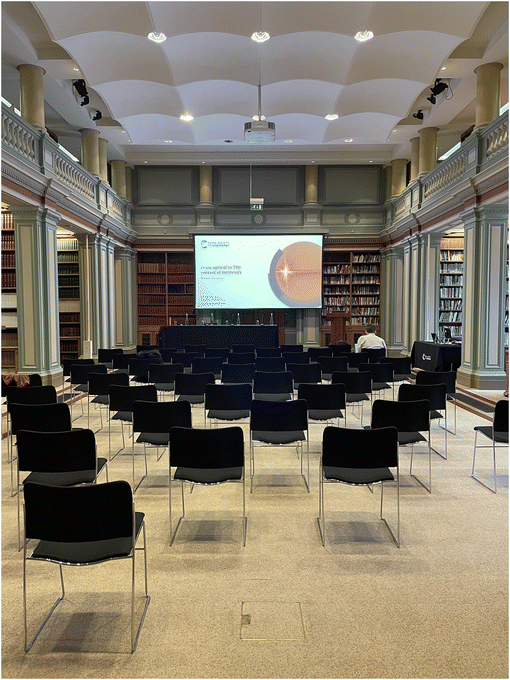 | ||
| Fig. 1 The historic RSC library in the beautiful Burlington House ready to welcome the Faraday Discussion delegates. | ||
Exploring molecular processes has been at the forefront of ultrafast science research for a very long time. Over the past decade, the investigation of ultrafast dynamics has expanded to materials science, with specific aspects related to solid-state such as the excitation of electrons in band structures, collective phonon excitations, and the development of experimental probes for electronic and structural reorganization such as X-ray free electron laser (XFEL) and angle-resolved photoemission spectroscopy (ARPES). The aim of this meeting was, therefore, to provide a roadmap of the current status of the field and to discuss challenges and opportunities over the next 5–10 years and beyond. With this in mind, the meeting was organized into four main themes: (i) material science: ultrafast transformation, electron–phonon coupling, multi-scale aspects, (ii) theory of out of equilibrium light-induced phenomena, (iii) optical excitation processes, and (iv) THz and laser field excitation processes. One of the key aspects of the meeting was the complementarity of experimental materials scientists and theoreticians exchanging ideas to design new ways to control materials and understand transformation processes. The organizing scientific committee was chaired by Prof. Eric Collet from the Université de Rennes 1, France and the committee comprised Prof. Lara Benfatto from the Sapienza University of Rome, Italy, Prof. Lin X. Chen from Northwestern University, USA, Dr J. Olof Johansson from the University of Edinburgh, Scotland, and Prof. Shin-ya Koshihara from Tokyo Institute of Technology, Japan.
Faraday Discussions meetings have a rich history of 115 years spanning over 300 meetings, with a unique format where the speakers' research papers are circulated to the delegates in advance. During the meeting, the authors present a 5 minute brief summary of the papers and the majority of the meeting is then devoted to an in-depth discussion of the work where participants ask questions to the authors, make suggestions, discuss complementary or contradictory measurements and calculations to the presented work, and also make links with other relevant work. Such a discussion-driven format provides ample opportunities for networking and exchange of ideas, critical assessment of the work leading to stimulating scientific debates and furthermore, fosters new collaborations. A written record of all the remarks made during the discussions is later published in the Faraday Discussions journal volume, alongside the discussed papers as part of a themed collection. Another unique aspect of the meeting is the Spiers Memorial Lecture given as an introductory lecture at each Faraday Discussions meeting. This was formerly known as the Spiers Memorial Award named after Frederick S. Spiers who co-founded the Faraday Division of the RSC, previously the Faraday Society, in 1903 and is awarded to a researcher who had made an outstanding contribution to a field relevant to Faraday Discussions.
It is interesting to note that, right from the start of these meetings in the 1900s, the focus was on the discussion aspect, and all the papers were circulated beforehand.1 Remarkably, the very first Faraday Discussion was on the topic of osmotic pressure for which the first-ever Nobel Prize in Chemistry was awarded in 1901.2 The initial meetings focused mostly on topics that would have been of direct interest to Michael Faraday himself. However, the scope of the meetings has broadened over the years, and they now cover a wide variety of topics at the interface of chemistry, physics, biology, materials science, and related fields. In fact, this Faraday Discussion served as a great example of an interdisciplinary meeting.
The meeting began with Prof. Eric Collet giving introductory remarks welcoming the attendees, and briefly introducing the discussion topics. He restated the role ultrafast techniques play in probing the real-time dynamics and structural changes in materials, and how new pump sources allow for selective activation and control of specific degrees of freedom (Fig. 2). Following that, Samuel Howell and Izzy Tibbetts, RSC publishing editors for this volume of Faraday Discussions (vol. 237), introduced the format of the discussions.
Introductory lecture
The introductory lecture was given by Prof. Steven L. Johnson, head of the Ultrafast Dynamics group at Eidgenössische Technische Hochschule (ETH), Zürich (https://doi.org/10.1039/d2fd00098a). The lecture served as an introduction to the meeting addressing selected aspects of light-driven material control research and emphasizing topics discussed in the conference papers.Prof. Johnson first gave an outline of the development in the field due to the advent of intense sources of short-pulse radiation in the THz and mid-infrared ranges, with a specific overview of the existing excitation mechanisms occurring in insulators, semiconductors, and superconductors. He particularly stressed that these different excitations couple to desired material parameters in a more efficient and non-destructive way with respect to higher frequency excitations. In the second part of the lecture, Prof. Johnson reviewed the existing potential control schemes indicating the key factors relevant to current studies and future work in the area. In particular, he discussed the control via the driving of (i) electronic transition, (ii) direct lattice excitation, (iii) the magnetic field of the pulsed radiation, and (iv) the strong electric field dressing of a material. Importantly, he addressed the issue of the dissipation of energy that could prevent an efficient control of the material properties.
Prof. Johnson talked not only about the excitation mechanisms but also about the development of experimental tools devoted to studying the transient material properties on femtosecond and picosecond timescales (XFEL- and ARPES-based probes). Finally, he gave a personal perspective on the major challenges in the control of strongly correlated systems, stressing that the cooperativity of competing orders can be employed to excite novel emergent properties. He further discussed the competition of linear and nonlinear responses at high field intensities. The discussions following the lecture focused on displacive excitation mechanisms and the importance of electronic coherence time with respect to pulse width. Given the high impact of Prof. Johnson's work, this introductory lecture was recognized as the Spiers Memorial Lecture.
Session 1: Material science: ultrafast transformation, electron–phonon coupling, multi-scale aspects
Following the introductory lecture, the session on material science focused on ultrafast transformation, electron–phonon coupling, and multi-scale aspects commenced after a short break. The session was chaired by Prof. Shin-ya Koshihara.The first talk of the session was on visualizing optically-induced strains by five-dimensional ultrafast electron microscopy (https://doi.org/10.1039/d2fd00062h) given online by Prof. Kyoko Ishizaka from the University of Tokyo. Prof. Ishizaka introduced the technique of five-dimensional scanning transmission electron microscopy (5D-STEM) as a powerful tool to obtain strain movies with nanometer × picosecond spatiotemporal resolution. She discussed how convergent beam electron diffraction (CBED) measurements using 5D-STEM enable wide-range detection (ps–μs and nm–mm scales) of optically induced multiscale dynamics in correlated materials. By performing CBED analysis on a patterned silicon single-crystalline plate as a model system, Prof. Ishizaka and co-workers demonstrated that time-dependent strain and polarization can be quantitatively mapped out in complex nano-fabricated samples. Furthermore, they suggested that such a method can play an important role in the future development of probing optically-controlled acoustic phenomena at the nanoscale.
The second talk of the session was on the ultrafast dynamics in (TaSe4)2I triggered by valence and core-level excitation (https://doi.org/10.1039/d2fd00019a) given by Dr Wibke Bronsch from Elettra Sincrotrone Trieste, Italy. Dr Bronsch talked about the out of equilibrium dynamics of a quasi-one-dimensional material (TaSe4)2I that exhibits different electronic band structures – metallic, insulating, or charge density wave phases along its different crystal axes. Using both optical and FEL time-resolved spectroscopic techniques, Dr Bronsch and co-workers monitor and compare the optical reflectivity changes in the material by selectively exciting either the valence band or the deep-lying core-level with optical and X-ray excitations respectively, driving specific out-of-equilibrium states. While reflectivity along the crystal a-axis exhibits bandgap renormalization effects for both the excitations, reflectivity along the c-axis exhibits different effects under X-ray and optical excitations. Interestingly, the charge density wave fingerprints were not observed with X-ray probes. Dr Bronsch suggested that theoretical studies and X-ray pump/optical broadband probe experiments are required to understand better and further elucidate the dynamics. The results of this study provide insights into controlling the functional properties of phase-changing materials.
The third and final talk of the session was on the ultrashort and metastable doping of the ZnO surface by photoexcited defects (https://doi.org/10.1039/d2fd00036a) given online by Prof. Julia Stähler from Humboldt-Universität zu Berlin, Germany. Prof. Stähler explained how the photoexcitation of deep electronic defects in particular materials such as Mott insulators create long-lived (10 μs) defect excitons comparable to shallow donors in chemical doping. In this work, Prof. Stähler and co-workers characterized defect excitons on the surface of ZnO using photoelectron spectroscopy and showed that photoexcitation even below the bandgap of ZnO leads to the formation of a transient metallic state. Further, they developed a model that describes the population of defect excitons on μs timescales. Prof. Stähler emphasized that the defect-driven metastable Mott transitions on ultrafast timescales are in fact, driven by photoionized oxygen vacancies that behave as shallow donors. In conclusion, she pointed out that photoexcitation of these defects having analogous spectroscopic signatures to chemical doping enables the transient control of material properties such as electrical conductivity in ultrafast timescales.
Session 2: Theory of out of equilibrium light-induced phenomena
Session 2 of the Faraday Discussion started on the second day and continued to the afternoon. Prof. Lara Benfatto chaired the session. In total, there were six talks.The first speaker of the session was Marc Alías-Rodríguez from the Universitat Rovira i Virgili, Spain, who talked about quantum dynamics simulations of the thermal and light-induced high-spin to low-spin relaxation in Fe(bpy)3 and Fe(mtz)6 (https://doi.org/10.1039/d2fd00027j). Marc discussed the spin cross-over for transition metal complexes with d4 and d7 configurations. In particular, he presented the theoretical analysis of the probability of thermal and light-induced transitions from the high-spin to the low-spin structure. Using Fermi's golden rule, Marc and co-workers determined the order of magnitude of the high-spin state lifetime in the thermal relaxation process with a satisfactory agreement with the experiment.
The second speaker of the session was Prof. Kunio Ishida from Utsunomiya University, Japan, who spoke about quantum entanglement control of electron–phonon systems by light irradiation (https://doi.org/10.1039/d2fd00007e). He discussed the entanglement properties of spin-phonon/spin-chain systems under photo-irradiation. The generation of quantum entanglement is the key to realizing quantum information devices. Prof. Ishida and co-workers calculated the quantum mutual information for phonons to numerically characterize the quantum entanglement in the electron–phonon–photon system. They discussed two different cases: case 1 was about two spin-phonon systems with antiferromagnetic interaction where the spin-singlet of nearest-neighbor spin is a crucial component in constructing the ground state of the infinite system. The numerical study showed the possibility of detecting light-induced entanglement in materials without using single-photon emitters. In case 2, he discussed two spin chains irradiated by entangled photons and showed that entangled light generates the entanglement between two remote systems. The main idea of the talk was to address the mechanism for the quantum control of transient states by light, for which they introduced quantum many-body states of the entire light–matter system to understand if light can modulate the entanglement properties of materials.
The third speaker, Dr Matteo Puviani from Max Planck Institute for Solid State Research, Germany, talked about the quench-drive spectroscopy of cuprates (https://doi.org/10.1039/d2fd00010e). In his talk, Dr Puviani discussed the nonlinear optical response and two-dimensional spectroscopy in cuprate superconductors with a d-wave pairing. Cuprates exhibit a complex phase diagram as a function of doping and temperature, with a superconducting dome enriched by charge-density wave and pseudogap phases. Matteo and his co-worker developed a theory for the quench-drive spectroscopy with an ultrashort intense pump pulse and a long-time weak probe (drive) pulse and utilized the pseudospin model and dynamical Bloch-equation formalism for the superconducting order parameter. He discussed both coherent pairing and incoherent pairing cases where for the latter, a random phase factor for the pairing term in the momentum space was imposed. They provided a detailed analysis of third harmonic generation using a two-dimensional Fourier transform versus measurement time t and quench-drive delay time Δt. An exciting part of nonlinear physics in a superconductor is the collective modes such as the Higgs mode that corresponds to the oscillation of the order parameter's amplitude. He discussed the effect of amplitude mode on the THz nonlinear response of a superconductor and addressed the enhancement of fifth harmonics and the emergence of a second-harmonic component in the power spectrum due to the overlap of the quenching and the driving pulses. Furthermore, considering an incoherent gap model, even for moderate incoherence, they obtained a decrease in the superconducting gap accompanied by partial or total suppression of the third harmonic response and the amplitude mode contribution to the nonlinear current.
The fourth speaker was Prof. Irene Burghardt from Goethe University Frankfurt, Germany, who presented numerical results of a study on signatures of coherent vibronic exciton dynamics and conformational control in the two-dimensional electronic spectroscopy of conjugated polymers (https://doi.org/10.1039/d2fd00014h). In this presentation, Prof. Burghardt discussed a comprehensive theoretical study of vibronic physics using two-dimensional electronic spectroscopy (2DES) in a conjugated polymer material. Introducing a lattice model of N-sites, she provided a theory that describes the collective vibronic modes with a particular focus on the coupling of polaronic and torsional excitations to model exciton migration at zero temperature. Employing a quantum–classical approach in which the torsional mode is modeled semiclassically and other dynamics are simulated fully quantum mechanically, she presented a microscopic formulation of equations of motion for the quantum state of the molecular system in the presence of light–matter interaction in a 2DES setup with two pulses with coherence time τ and a probe pulse (after waiting time T). Prof. Burghardt explained the impact of soft torsional and high-frequency polaronic modes' dynamics on the exciton migration based on third-order nonlinear spectroscopy by analyzing 2D spectral maps at different waiting times. She noted that the adiabatic exciton evolution driven by soft torsional mode fluctuations can be utilized for the active control of exciton dynamics due to soft modes.
The fifth speaker was Mattia Udina from the Sapienza University of Rome, Italy, who delivered a talk on THz non-linear optical response in cuprates: predominance of the BCS response over the Higgs mode (https://doi.org/10.1039/d2fd00016d). Recent experiments in nonlinear optics of unconventional superconductors have attracted a surge of attention in THz physics, as it presents a direct approach to detecting the amplitude of the Higgs mode response. However, it is still a matter of debate if the enhancement of THz nonlinear response of superconductors is attributed to the Higgs mode or the Bardeen–Cooper–Schrieffer (BCS) quasiparticles. Mattia and co-workers provide an answer to this question by performing explicit calculations using quantum field theoretical approaches. Mattia mentioned that the quasiparticle contribution dominates the Higgs one. He gives an exciting guideline by analyzing the polarisation dependence of the third harmonic signal in a superconductor which can be very useful for spectroscopy schemes to disentangle the contribution of Higgs from quasiparticles. Considering the impact of the disorder, Mattia discussed a possible cross-over from the quasiparticle dominant signal to the Higgs dominant signal when one cranks up the disorder strength. Moreover, he highlighted that accounting for disorder helps to reproduce experimental data for the isotropic dependence of the nonlinear signal on the polarisation angle.
The last speaker of the session was Prof. Ilya M. Eremin from Ruhr-University Bochum, Germany, who discussed a study on signatures of collective modes in the fifth harmonic generation of BCS superconductor (https://doi.org/10.1039/d2fd00067a). Prof. Eremin started his talk by highlighting the impact of different collective modes, such as Higgs mode and plasmon mode in unconventional superconductors. He mentioned that a sub-dominant s-wave order parameter could be activated in a d-wave unconventional superconductor owing to light-induced inversion symmetry breaking. He discussed the theoretical results of the fifth harmonic generation in light of the recent experimental measurements. The main message of the talk was that, for the fifth harmonic generation, the major contribution comes from the BCS quasiparticles.
Session 3: Optical excitation processes
The afternoon session commenced with the third session of the meeting focused on optical excitation processes, co-chaired by Prof. Lin Chen and Dr Olof Johansson.The first talk was on the out-of-equilibrium dynamics driven by photoinduced charge transfer in CsCoFe Prussian blue analogue nanocrystals (https://doi.org/10.1039/d2fd00015f) given online by Dr Serhane Zerdane from Paul Scherrer Institut, Switzerland. Dr Zerdane and co-workers used femtosecond X-ray and optical absorption spectroscopic techniques to study the photoinduced charge transfer in CsCoFe nanocrystals of two different sizes. Specifically, they explored the charge transfer (CT) from CoIIIFeII to CoIIFeIII and characterized the structural, optical and magnetic changes of the metastable state. Dr Zerdane explained the process as a multi-step evolution in which (1) at first, the photoinduced spin transition stabilizes the CoIIFeIII state and induces the CT process within 200 fs, (2) and thereafter the lattice torsion modes get activated followed by (3) local lattice distortion and (4) subsequent elastic dispersion of wave propagation through the sample, (5) resulting in the macroscopic volume expansion and breathing of nanocrystals. He mentioned that the propagation of elastic waves associated with the macroscopic volume expansion turned out to be crystalline size dependent whereas the dynamics of other local processes were independent of the size, suggestive of the multiscale nature of photoinduced processes in molecular materials.
The second talk titled nonequilibrium dynamics of α-RuCl3 – a time-resolved magneto-optical spectroscopy study (https://doi.org/10.1039/d2fd00006g) was given by Julian Wagner from the University of Cologne, Germany. He presented α-RuCl3 as an interesting material to explore because it is a magnetic Mott–Hubbard insulator that is also considered to be a prime candidate to realize the Kitaev quantum spin liquid ground state. He noted that α-RuCl3, which has no magnetic order at room temperature shows antiferromagnetic ordering at low temperatures. Using transient magnetic linear dichroism measurements with fluences varying above and below the Néel temperature, Wagner and co-workers probe the magnetization and recovery dynamics in the material, looking to quench the magnetic order upon photo-excitation. He explained what happens at different regimes of the magneto-optical response. At low excitation densities, holons and doublons decay predominantly via magnon emission whereas, for intermediate densities, excitons break into holons and doublons. Above a certain threshold, the hopping of unbound holons and doublons perturbs the zigzag order. Along with demonstrating the presence of a long-lived spin-disordered non-thermal state, this study also indicates that the recovery dynamics can be understood in terms of the magnetic reordering process.
The third talk, ultrafast branching in intersystem crossing dynamics revealed by coherent vibrational wavepacket motions in a bimetallic Pt(II) complex (https://doi.org/10.1039/d2fd00009a), was remotely given by Dr Pyosang Kim from Northwestern University, USA. He presented a femtosecond broadband transient absorption (fs-BBTA) spectroscopy study on a cyclometalated platinum(II) dimer known to undergo a Pt–Pt bond contraction in the metal–metal-to-ligand-charge-transfer (MMLCT) excited state. By correlating the temporal evolution of stimulated emission and coherent vibrational wavepacket (CVWP) signals, he demonstrated two intriguing aspects of intersystem crossing (ISC) processes: (1) the initially populated MMLCT state branches into the direct (1MMLCT → 3MMLCT) and indirect ISC path (1MMLCT → 3LC → 3MMLCT) mediated by a triplet ligand-centered 3LC intermediate and (2) the ultrafast branching occurs before completing the Pt–Pt bond contraction on the 0.2 ps time scale. The experimental evidence presented by Pyosang and co-workers suggests that the photoinduced Pt–Pt contraction is a key structural factor in determining the ultrafast ISC and the CVWP transfer in the vicinity of the Franck–Condon (FC) region.
After a short break, the session continued with the talk by Prof. James McCusker from Michigan State University, USA on the use of vibronic coherence to identify reaction coordinates for ultrafast excited-state dynamics of transition metal-based chromophores (https://doi.org/10.1039/d2fd00106c). Prof. McCusker discussed the interplay between coherence, dephasing time, and the electronic and geometric structure of molecular systems. He started with an open question of whether we can use information from quantum coherences to inform on the vibrational degrees of freedom along an excited state reaction coordinate for ultrafast dynamics. He compared the photophysics of two chemical systems, [Fe(L)]2+ and [FeCu2(L)]4+ and observed that increasing the rigidity along the torsional coordinate inferred from vibrational coherence results in a 25-fold increase in MLCT lifetime from 110 fs to 2.6 ps. He further presented a different chemical system Cr(acac′)3 (acac′ represents various derivatives of acetylacetonate) that counters the previous observation. Cr-based derivatives showed wide variations in dephasing times from 340 fs to over 2 ps and did not reveal any clear correlation with evolution along the operative reaction coordinates. Interestingly, he concluded with the initial open question of whether dephasing time is a useful metric for differentiating active versus spectator modes for ultrafast excited state dynamics.
The fifth talk of the session was given online by Prof. Hermann A. Dürr from Uppsala University, Sweden on ultrafast manipulation of the NiO antiferromagnetic order via sub-gap optical excitation (https://doi.org/10.1039/d2fd00005a). Prof. Dürr presented time-resolved resonant X-ray reflectivity measurements in NiO following a femtosecond 1.5 eV sub-gap excitation performed using a FLASH free-electron laser. He showed that light-induced change in the spin temperature leads to a reduction of the antiferromagnetic order. At the same time, a renormalization of the upper gap edge occurs, accompanied by a 1 THz magnon oscillation in the upper gap-edge red-shift. Remarkably, Prof. Dürr showed electronic structure calculations indicating that magnon excitations significantly contribute to the reduction of the NiO band gap. Further discussions were devoted to the lifetime of the bandgap renormalization and oscillation.
In the last talk of this session, Prof. Mohammed Hassan from the University of Arizona, USA discussed attosecond electronic delay response in dielectric materials (https://doi.org/10.1039/d2fd00002d). He presented a new all-optical attosecond metrology to study the light-field induced electron dynamics in dielectric systems based on the phase transition of a dielectric material arising from its interaction with a strong light field. Prof. Hassan showed how the dielectric material experiences an adiabatic semimetal phase transition due to the strong polarizability. Prof. Hassan and co-workers studied the transient phase transition dynamics of the dielectric systems SiO2 and CaF2. In particular, he showed that the reflectivity changes of the material follow the shape of the pump field. He explained the observation by an inter- and intra-band transition of the charge carriers which causes a modification in the electronic structure, dielectric constant, and optical properties of the dielectric system.
Session 4: THz and laser field excitation processes
The fourth session of the Faraday Discussion on THz and laser field excitation processes was co-chaired by Dr Olof Johansson and Prof. Shin-ya Koshihara. The session focused on more selective and directive techniques compared to optical techniques resulting in novel excitation processes that can switch the ground state of materials.In the first presentation, Prof. Shinichiro Iwai from Tohoku University, Japan talked about the petahertz charge dynamics in a correlated organic superconductor (https://doi.org/10.1039/d2fd00004k). Prof. Iwai presented the observation of a nonlinear coherent charge oscillation in the correlated organic superconductor (κ-(h-ET)2Cu[N(CN)2]Br) in the petahertz range by means of stimulated emission. He showed that an unconventional second harmonic generation by the centrosymmetric material indicates the presence of light-induced currents occurring before the electronic scattering time. Remarkably, the non-linearities induced by the petahertz charge oscillations are enhanced around the superconductive transition temperature, giving insight into the microscopic mechanism of superconducting fluctuations in this material.
The next speaker, Prof. Jan Michael Rost from Max Planck Institute for the Physics of Complex Systems, Germany discussed the local excitation and valley polarization in graphene with multi-harmonic pulses (https://doi.org/10.1039/d2fd00017b). He introduced a novel compact representation for excitations, locally resolved in the initial conditions for the crystal momenta. Further, he gave a detailed picture of how intense laser pulses affect excitation and valley polarization in graphene explaining how a long wavelength and a moderate number of overtones in the harmonic pulse generate the largest valley polarizations.
In the third presentation, Dr Rostislav V. Mikhaylovskiy from Lancaster University, UK talked about modelling nonlocal nonlinear spin dynamics in antiferromagnetic orthoferrites (https://doi.org/10.1039/d2fd00035k). He introduced an open question: what kind of propagating spin dynamics can one excite in the nonlinear regime with a strongly localized excitation? To answer this question, he presented a theoretical model describing the nonlocal and nonlinear spin response to an ultrashort light pulse excitation. He showed the temporal and spatial characteristics of the spin dynamics in the nonlinear regime in antiferromagnets, such as rare-earth orthoferrites. In particular, he showed that strongly localized ultrafast excitation can drive spin switching, which propagates in space and acts as a source of spin waves.
In the last presentation of the session, Guénolé Huitric from Institut de Physique de Rennes, France discussed the impact of the terahertz and optical pump penetration depths on generated strain waves temporal profiles in a V2O3 thin film (https://doi.org/10.1039/d2fd00013j). He compared the optical response on an acoustic timescale of a V2O3 paramagnetic metallic thin film excited with a THz pump or an optical pump at room temperature. He showed that the penetration depth of the deposited energy has a strong influence on the shape of the optical transmission signal, where the strain–stress profile is a key feature. In particular, he highlighted that THz excitation allows for inducing a more spatially homogeneous excitation than an optical pump and further, reported the first experimental evidence of modulation of optical transmission in V2O3 with a THz pump within the acoustic timescale.
Closing lecture
The concluding remarks lecture was delivered by Prof. Graham Fleming from the University of California, Berkeley, on directing and controlling materials and molecules (https://doi.org/10.1039/d2fd00133k).Prof. Fleming's talk covered the field of THz optical spectroscopy in quantum chemistry and quantum materials in a broad scope. He highlighted five grand challenges for science and the imagination, addressing the following questions. (1) How do we control materials and processes at the level of electrons? (2) How do we design and perfect atom- and energy-efficient synthesis of new forms of matter with tailored properties? (3) How do remarkable properties of matter emerge from complex correlations? (4) Can we master energy and information on the nanoscale to create new technologies? (5) How do we characterize and control matter away from equilibrium? He stressed that the non-thermal effect of short laser pulses can be utilized to probe the ground state, and can be employed to switch between different stable and metastable phases of the system. Ultrashort and intense pulses induce non-equilibrium critical behavior and thus transiently manipulate the free energy landscape. Despite technological advances in coherent controlling quantum materials by new light sources such as free electron and THz lasers, there are basic challenges in understanding the coherent spectroscopy of complex materials. In particular, he highlighted the importance of non-thermal coherent controlling and optical switching into metastable states, having applications in low-temperature microelectronics.
Further, Prof. Fleming discussed two-dimensional vibrational spectroscopy as a powerful tool to probe the correlation between electrons and nuclei dynamics. In particular, he highlighted 2D electronic vibrational (2DEV) spectroscopy which is very sensitive to the vibronic mixing that can allow mapping from evolution in energy to real space. For example, he discussed the 2DEV spectra of a light-harvesting complex (LHCII chlorophyll) and looked at cross-correlation versus auto-correlation. As a second example, he illustrated the 2DEV spectra from the proton-coupled electron in a biomimetic electron double proton transfer system (PF15-BIP-Pyr). The study of vibronic states in 2DEV spectra of excitonic systems signifies that the soft mode excitation can control and regulate dynamical disorder to optimize transport properties. A highly important phenomenon for coherent controlling in quantum materials such as superconductors and quantum information systems is to manipulate coherence-destroying processes such as electron scattering and spin–lattice relaxation.
Quantum light can control and probe features beyond classical light, such as entanglement time and joint spectra. This new control knob can gain better spatiotemporal resolution with new aspects of information and control in spectroscopy experiments. Moreover, frequency–time entangled single-photon pairs can break the Fourier transformation limit (i.e., uncertainty principle) between frequency and time for simultaneously improved spectral and temporal resolution, i.e., high time resolution with a narrow band source. In particular, Prof. Fleming raised the question of whether we can experimentally prove that an incoherently excited system evolves with quantum mechanical coherence. Low-intensity nonlinear spectroscopy and imaging of fragile systems is another standpoint of quantum light sources.
Finally, Prof. Fleming opened an interesting discussion on whether coherence observed for the femtosecond light sources is relevant to the photosynthesis process in sunlight, which is an incoherent thermal light source. Recent studies seem to confirm that ultrafast spectroscopy results also apply to quantum materials under sunlight. He discussed the concept of optical control in two senses: (1) the act of directing and regulating, and (2) the act of preventing something unwanted. Interestingly, he briefly talked about the control system used by plants on earth while discussing the concept of feedback control to optimize output and minimize damage. The outlook in this regard could be to optimize control systems in plants in response to excess sunlight, highly relevant for food production in the future, for instance, by 2050 as the population outpaces production. As open problems, such complex controls can also be applied to materials systems. Addressing these challenging questions, which require manipulating different degrees of freedom such as chemical, optical, electronic, magnetic, mechanical, and thermal, potentially offers many science and technology opportunities.
Conclusion & outlook
The unique format of the Faraday Discussion allowed for stimulating in-depth discussions (https://doi.org/10.1039/d2fd90035a, https://doi.org/10.1039/d2fd90036j, https://doi.org/10.1039/d2fd90037h, https://doi.org/10.1039/d2fd90038f) and defined new horizons for studying ultrafast phenomena triggered by optical and terahertz radiation in condensed matter systems. The discussion topics mainly concentrated on the contributions to the material response given by nonlinear currents due to strong field amplitudes and the use of free electron laser-generated radiation as a probing tool for emergent phenomena. Both theoreticians and experimentalists were actively involved in the discussions after each session, and the social interactions were concentrated during the poster sessions, lunch breaks, and the conference dinner. A total of 24 posters were presented and the poster sessions occurred in a hybrid (online and in-person) format. The sessions witnessed several productive moments in which young researchers received thought-provoking questions from the delegates. Remarkably, more than one collaboration between senior and young researchers was established during the poster sessions. Ms Erica Sutcliffe from the University of Edinburgh, UK, won the poster prize sponsored by the journal Physical Chemistry Chemical Physics (PCCP) for a poster on broadband, ultrafast magneto-optics in a layered Cr2Ge2Te6 ferromagnet (Fig. 3).The conference dinner occurred on the second day, where the informal context allowed for additional discussions devoted not only to science but also to the role of scientists in promoting the sustainability of the planet. During the dinner, Professor Steven Johnson was awarded by Professor Dwayne Heard, President of the Faraday Community for Physical Chemistry, a medal in recognition of the Spiers Memorial Lecture (Fig. 4), and the celebration was followed by the historic Loving Cup Ceremony attended by all the participants. The Loving Cup, reputedly made by the lady silversmith Heslie Fawdery, dates back to 1728 (Fig. 5 and 6) and is used at Faraday Discussions conference dinners to toast in piam memoriam of G. S. Marlow and Angela and Tony Fish.
In conclusion, the 2022 Faraday Discussion ‘From optical to terahertz control of materials’ successfully addressed new ways to control materials and understand transformation processes, providing a roadmap of the current status of the field, the challenges lying ahead, and potential ways to address those. Overall, the meeting at the beautiful Burlington House was an enriching and memorable experience that not only facilitated fruitful scientific discussions but also established new collaborations and friendships.
Acknowledgements
A. V. G. acknowledges funding from the European Research Council Studentship and Trinity-Henry Barlow Scholarship. H. R. is supported by Nordita and the Swedish Research Council (VR Starting Grant No. 2018-04252). Nordita is partially supported by Nordforsk. M. B. acknowledges support from the Knut and Alice Wallenberg 233 Foundation, grant no. 2017.0158 and 2019.0068.References
- S. Weatherby, J. Seddon and C. Vallance, Faraday Discuss., 2019, 214, 9–12 RSC.
- W. C. D. Whetham, Trans. Faraday Soc., 1907, 3, 12–13 RSC.
Footnote |
| † Authors contributed equally to the article. |
| This journal is © The Royal Society of Chemistry 2023 |

